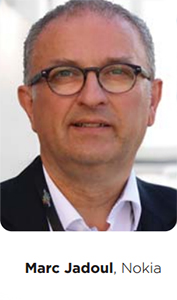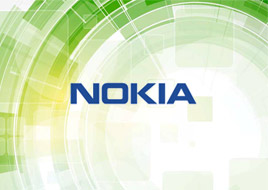The IoT platform landscape is among the most dynamic and rich areas in the IoT community. Here, Saverio Romeo, the principal analyst at Beecham Research, interviews Marc Jadoul, the market development director for Internet of Things at Nokia to learn about the company’s view on the IoT and its IMPACT (Intelligent Management Platform for All Connected Things)
Saverio Romeo: What strategic argument is leading Nokia in the Internet of Things arena?
Marc Jadoul: Nokia creates the technology to connect the world. Powered by the research and innovation of Nokia Bell Labs, we serve communications service providers (CSPs), governments, large enterprises and consumers with the industry’s most complete, end-to-end portfolio of products, services and licensing. Our company mantra is all about shaping the future of technology to transform the human experience. We strongly believe that IoT networks, platforms, applications, and ecosystems are instrumental to realizing that vision. We enable that through four key areas: mobile broadband and 5G networks for the IoT, cloud and software solutions, security solutions, and connected devices.
SR: How do you see the status of the IoT market?
 MJ: The term IoT is used all around, but there is no single definition for it. IoT is an evolution of machine-to-machine (M2M) communication, which enables networked devices to exchange information and perform actions without the manual assistance of humans.
MJ: The term IoT is used all around, but there is no single definition for it. IoT is an evolution of machine-to-machine (M2M) communication, which enables networked devices to exchange information and perform actions without the manual assistance of humans.
There is an essential difference between M2M and IoT: how the data is generated by all these devices and how it is used to create value. IoT is fuelled by the convergence of M2M communications and big data analytics.
While traditional M2M applications often target the automation, and industrial systems and processes, the IoT provides companies with innovative means for new products and services. Today, we are basically still very much in a M2M era, but things are moving fast towards the IoT vision. The IoT Community, which is the name of Nokia’s IoT ecosystem, has all the tools for enabling that rapid transition.
SR: Besides different interpretations and forecasts of the future of IoT, the consensus is that we are moving towards fully connected environments. Which is the key element for enabling that evolution?
MJ: Nokia considers IoT technologies as a means for realizing the programmable world vision, which is an ultra-connected environment in which massive numbers of objects will become bound together with intelligence that is built upon vast amounts of data processed in the cloud and used to automate and simplify processes, and to create new services.
Connectivity is a key feature for the programmable world. Connected devices need robust and scalable connectivity. Today there are many different access technologies, but not all are addressing the critical needs for IoT connectivity, security and battery life. This is the key reason for the emerging 3GPP standards – NB-IoT, LTE-M, EC-GSM – in low power wide area networks (LPWAN).
High availability and low latency will be required for many critical IoT solutions. Extended coverage will be essential to penetrate deep into buildings, while Multi-access Edge Computing (MEC) allows to rapidly process content at the very edge of the network. And, finally, 5G will enable the data-rich applications of the IoT.
SR: Connectivity is then a building block for your vision of the IoT. Can you tell me more about the role of software and platforms?
MJ: Technological developments in storage, processing, visualisation, cloud networking and artificial intelligence (AI) are opening new roads for application innovation and new value creation. By adding software intelligence and automation into every connection, process and service, new opportunities are becoming possible. The value of the IoT lies in the data, its manipulation and its representation. Therefore, IoT-specific IT and operations technology (OT) platforms play a crucial role.
Eventually, IoT is going to become an integral part of the evolving enterprise IT environment. Enterprise architects will be looking for common off the shelf (COTS) components, and work with system integrators that can make them fit with their current IT infrastructure, rather than deploying vendor-driven end-to-end solutions. In this scenario, data integrity, privacy and security are prime concerns to take into consideration.
SR: How does IMPACT help the move towards fully connected environments?
MJ: A horizontal platform breaks the silos of the M2M world facilitating development of different applications just reusing the platform features. The connected environments are then developed quickly and more cost efficiently. IMPACT does that. It enables application developers, device manufacturers and service providers to use common infrastructures, and share platform functions and data.
SR: Can you then describe the key features of IMPACT?
MJ: IMPACT stands for an Intelligent Management Platform for All Connected Things. It provides customers with a standards-based platform for securely managing any device, protocol, or application. The key elements of IMPACT are:
• IMPACT’s device management function already provides lifecycle management for more than 1.5 billion managed devices and 80,000 device types are recognised.
• Data collection layers between the devices or aggregators and the applications facilitate data acquisition as well as fault and power monitoring, provisioning, configuration, remote diagnostics
• IMPACT securely onboards devices. It collects and analyses the data gathered from these devices. These are exposed through an application programme interface (API) layer with an extensible object model that allows for flexible devices and use cases to be added without programmatic change.
• It also provides a console for remote monitoring data and event. It provides an application enablement component that helps platform users to develop applications.
• The platform also includes network, cloud and end-point security. It implements the latest Lightweight M2M (LWM2M) security model for IoT device management and is backed by Nokia’s extensive security portfolio.
• Finally, a connectivity management component manages high volumes of connections from sensors and devices, including those that with embedded SIMs and eSIMs and LPWAN devices. It also offers flexible deployment and modules for billing, mediation and customer relationship management (CRM).
• IMPACT is agnostic from a connectivity point of view.
• IMPACT can be simply integrated with third party application enablement and connectivity management platforms.
SR: Can you share some examples of how IMPACT can serve different sectors and applications?
MJ: In the applications layer, we have a two-sided approach. On one hand, we are building-out our ecosystem, which already has over 340 partners. But we are also implementing several use cases that focus on a selected number of verticals, for which we see clear market drivers and viable business cases. These include examples in the automotive, utilities, public safety, smart cities and healthcare industries.
SR: Does IMPACT enable those applications or does the offering include a set of predeveloped application services as well?
MJ: The latest release of the IMPACT platform comes with a starter pack of pre-integrated applications that allow customers to deploy a initial set of secure revenue-generating IoT services for smart cities and fleet managers: video analytics powered by Nokia Bell Labs’ machine learning algorithms, smart parking application, smart lighting application, and vehicle applications.
IMPACT is also a component of the Nokia smart home solution, based upon our Z-Wave and ZigBee enabled residential gateway, and a mobile application for your smartphone or tablet to control and manage the devices.
SR: On what type of business model is IMPACT based? Do you offer related services such as support and integration with other solutions?
MJ: The IMPACT platform is multi-tenant and can be provided as an on-premise as well as a cloudbased solution. It enables secure XaaS hosting of devices, applications and data from different IoT service providers. IMPACT combines with our NetGuard security portfolio to monitor IoT devices, detect malware, draw correlations between events in different parts of the network, and set security parameters to minimise the chance of successful attacks. Furthermore, our Global Services people have the expertise to design, plan, integrate and customise the connectivity, platform and application layers to meet the needs of different customers. And finally, we have recently launched the Nokia Worldwide IoT network grid, our global managed connectivity service that enables CSPs to quickly become IoT providers.










